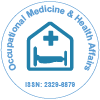E-Health: Transforming Healthcare in the Digital Age
Received: 01-May-2025 / Manuscript No. omha-25-171464 / Editor assigned: 03-May-2025 / PreQC No. omha-25-171464 / Reviewed: 17-May-2025 / QC No. omha-25-171464 / Revised: 22-May-2025 / Manuscript No. omha-25-171464 / Published Date: 29-May-2025 DOI: 10.4172/2329-6879.1000584
Introduction
E-health refers to the use of digital technologies and electronic communication tools to deliver healthcare services, manage health information, and promote overall well-being. It encompasses a wide range of applications, including telemedicine, electronic health records (EHRs), mobile health (mHealth) apps, wearable devices, and health information systems. As healthcare systems face rising costs, growing demand, and accessibility challenges, e-health has emerged as a powerful solution to improve efficiency, expand access, and empower patients [1,2].
Discussion
The scope of e-health is vast, spanning clinical care, public health, education, and research. One of its most recognized forms is telemedicine, which allows patients to consult healthcare providers remotely through video calls, chat platforms, or mobile apps. This not only reduces travel time and costs but also ensures continuity of care for patients in rural or underserved areas. The COVID-19 pandemic accelerated the adoption of telemedicine worldwide, proving its value in maintaining healthcare delivery during crises [3-6].
Another vital component of e-health is the electronic health record (EHR) system. EHRs store patient data digitally, enabling easy access, accurate record-keeping, and secure information sharing among healthcare professionals. This improves diagnostic accuracy, reduces duplication of tests, and enhances coordination in patient care. With integrated decision-support tools, EHRs also help physicians make evidence-based decisions, leading to better clinical outcomes [7,8].
Mobile health, or mHealth, has become increasingly popular with the widespread use of smartphones and wearable devices. Apps that track physical activity, monitor chronic diseases, remind patients about medications, or provide mental health support empower individuals to take charge of their health. Wearables like smartwatches can monitor heart rate, sleep patterns, and even detect irregularities such as atrial fibrillation, offering early warnings and preventive care opportunities.
E-health also benefits healthcare providers and systems. Digital platforms streamline administrative processes such as scheduling, billing, and prescription management, reducing inefficiencies and administrative burdens. Big data analytics and artificial intelligence (AI) further enhance e-health by enabling population health monitoring, disease trend prediction, and personalized treatment strategies [9,10].
Despite its promise, e-health faces challenges. Data privacy and security remain significant concerns, as sensitive health information must be protected from cyberattacks and unauthorized access. Digital inequality also poses a barrier; not all patients have access to reliable internet, smartphones, or the digital literacy required to benefit from e-health services. Additionally, healthcare providers may face resistance to adopting new technologies due to training requirements, costs, and workflow disruptions. Addressing these challenges requires investment in infrastructure, strong regulatory frameworks, and public awareness campaigns.
Conclusion
E-health is revolutionizing the way healthcare is delivered, making it more accessible, efficient, and patient-centered. By integrating technologies such as telemedicine, EHRs, mHealth apps, and wearable devices, e-health empowers patients, supports healthcare professionals, and strengthens health systems. However, for e-health to reach its full potential, issues of equity, security, and adoption must be addressed. As digital innovation continues to evolve, e-health offers a pathway toward more resilient, inclusive, and sustainable healthcare systems, ultimately improving health outcomes for individuals and communities worldwide.
References
- Tillmann S, Tobin D, Avison W, Gilliland J (2018) Mental health benefits of interactions with nature in children and teenagers: a systematic review. J Epidemiol Community Health 72:958-966.
- Medlock M, Weissman A, Wong SS (2017) Racism as a unique social determinant of mental health: Development of a didactic curriculum for psychiatry residents. MedEdPORTAL 13:106- 118.
- Dennis GC (2001) Racism in medicine: Planning for the future. J Natl Med Assoc 93:1-5.
- Ellerbroek L (2007) Risk based meat hygiene--examples on food chain information and visual meat inspection. Dtsch Tierarztl Wochenschr 114:299-304.
- Shanahan L, McAllister L, Curtin M (2009) Wilderness adventure therapy and cognitive rehabilitation: Joining forces for youth with TBI. Brain Inj 23:1054-1064.
- Herrman TJ, Langemeier MR, Frederking M (2007) Development and implementation of hazard analysis and critical control point plans by several U.S Feed manufacturers. J Food Prot 70:2819-2823.
- Hufner K, Ower C, Kemmler G, Vill T, Martini C, et al. (2020) Viewing an alpine environment positively affects emotional analytics in patients with somatoform, depressive and anxiety disorders as well as in healthy controls. BMC Psychiatry 20:385-400.
- Lloyd-Richardson EE, Jelalian E, Sato AF, Hart CN, Mehlenbeck R, et al. (2012) Two-year follow-up of an adolescent behavioral weight control intervention. Pediatrics 130(2):e281-288.
- Coppens P, da Silva MF, Pettman S (2006) European regulations on nutraceuticals, dietary supplements and functional foods: a framework based on safety. Toxicology 221(1):59-74.
- Jong M, Lown EA, Schats W, Mills ML, Otto HR, et al. (2021) A scoping review to map the concept, content, and outcome of wilderness programs for childhood cancer survivors. PLoS One 16(1):e0243908.
Citation: Sara F (2025) E-Health: Transforming Healthcare in the Digital Age. Occup Med Health 13: 584. DOI: 10.4172/2329-6879.1000584
Copyright: © 2025 Sara F. This is an open-access article distributed under the terms of the Creative Commons Attribution License, which permits unrestricted use, distribution, and reproduction in any medium, provided the original author and source are credited
Select your language of interest to view the total content in your interested language
Share This Article
Recommended Journals
Open Access Journals
Article Tools
Article Usage
- Total views: 146
- [From(publication date): 0-0 - Dec 09, 2025]
- Breakdown by view type
- HTML page views: 101
- PDF downloads: 45
